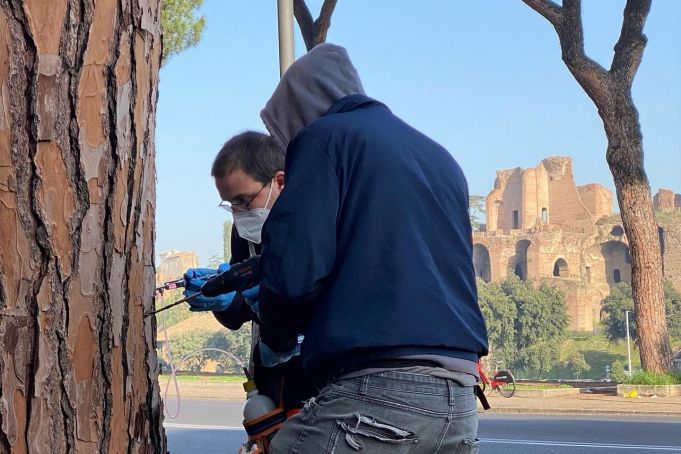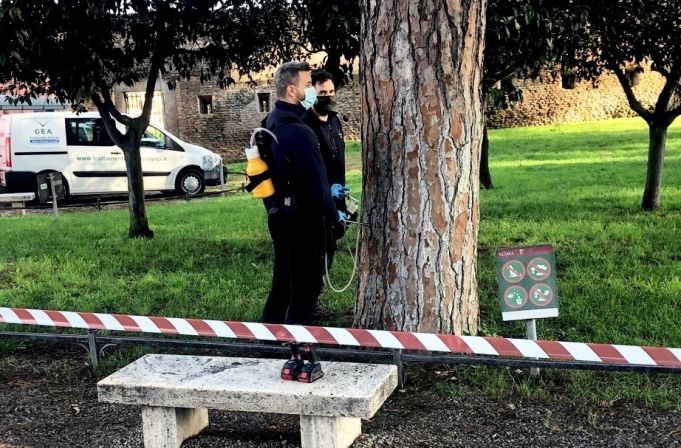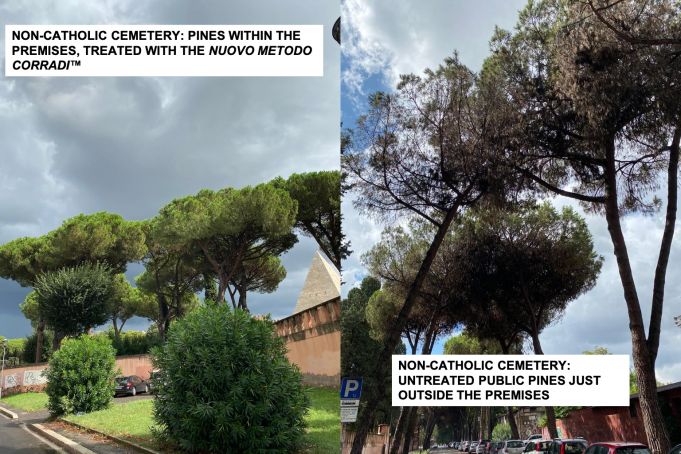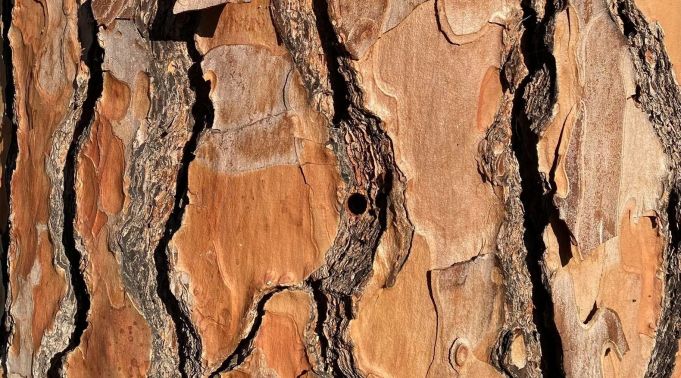The race to save Rome's pines before it's too late
The city, the Vatican and private firms undertake a variety of treatments in the battle to save Rome's pine trees from a killer parasite
By Andy Devane
On a sunny morning in November, a small crowd of curious passersby stopped to watch two men drill and inject a stone pine, or umbrella pine (pinus pinea), near the subway station at the Circus Maximus.
The unusual sight was part of an experimental project, financed by the city, to save 200 pines from an insect responsible for decimating these distinctive trees in Rome's suburbs.

The two-month scheme, costing €75,000, involves injecting the tree trunks with various treatments to counteract the pine tortoise scale insect (toumeyella parvicornis), as well as pruning infected branches and fertilising the roots.
Vicious cycle
The deadly parasite feeds off the sap of trees and causes the spread of a sooty black mould, leading to extreme needle loss.
The pine fights back by generating new needles which, in turn, weakens the tree and exposes it to new attacks by the parasite. It is a vicious cycle that – if untreated – can kill the exhausted tree within two years.
The city says the trial project will attempt to discover the most effective treatments in dealing with the parasite, which arrived in Italy from North America in 2015. The highly-invasive bug was first detected in the southern Campania region, around Naples, which is home to a large US naval base.
Alarm
The pest has since spread out across south-central Italy, mainly in urban areas, at an alarming rate.
It didn't take the insects long to move up the coast to Rome where they have already destroyed pines in the southern suburbs of Mostacciano, Spinaceto and Castel di Decima, and now their effects are being seen in the centre whose picture-perfect pines are an integral part of the cityscape.
Dreaded parasite
Recently residents of the capital may have noticed unusually heavy carpets of pine needles, covered in sticky honeydew, under the city's pines. Look up – if the tree's foliage has the appearance of being burnt then it is most likely the victim of the dreaded parasite.
As a non-indigenous species, the pest has no natural predator in Italy meaning that it can multiply and spread unchallenged by nature.
The city's trial project at the Circus Maximus follows calls during the summer by Rome councillor Ilaria Piccolo, of the centre-left Partito Democratico (PD), who said that "50,000 pine trees" are hanging in the balance. "The risk of collapse threatens the safety of citizens" – Piccolo said – "and Rome risks losing an ancient tree heritage of inestimable value."
Giardino degli Aranci
Separately and not far away, a pioneering public-private project is underway at the Giardino degli Aranci, Rome's impossibly beautiful orange garden atop the Aventine hill.
The project is the result of a collaboration between the city and Amici dell'Aventino, an historic association dedicated to preserving the unique heritage of the Rione Ripa which includes the Aventine.

The association pitched its proposal to the city's garden service to use the Giardino degli Aranci as a high-profile showcase for a new treatment called the Nuovo Metodo Corradi™ (NMC), patented by Italian firm GEA Snc that is proving highly effective against parasites including the pine tortoise scale insect.
Based in Verona, GEA uses chemical and biological products to safeguard trees and has been at the forefront of antiparasitic endotherapy treatments in Europe since 2001.
Amici dell'Aventino
The Servizio Giardini is struggling to keep up with the newly-arrived parasite, which has led to many trees falling or being felled throughout Rome, and the city readily accepted the offer by Amici dell'Aventino.
The NMC is different to the treatment being trialled on the nearby Circo Massimo pines, with both methods being tested in the same area in order for the city to compare their effectiveness on a side-by-side basis.
Amici dell'Aventino vice-president, Enrico Barbieri, told Wanted in Rome: “All of the trees on the Aventino, including the pines and orange trees at the Giardino degli Aranci, are protected by law. This is because the Aventino itself, as one of the most ancient parts of the historic centre of Rome, is a UNESCO site.”
Barbieri says that his association hopes to engage large private corporations in the sponsoring of replanting as well as preventive treatment of trees on the Aventino and throughout the Rione Ripa.
Nuovo Metodo Corradi
So what exactly is the NMC method used by GEA Snc in treating pine trees against parasites? It is an endotherapy technique that consists in manual injections of a phyto-drug (a pharmaceutical product of plant origin) designed to eliminate disease in trees.
Francesco Zanella of GEA told Wanted in Rome: “The technique allows for phytosanitary treatment to be injected directly into a tree's vascular system, thereby transporting it throughout the lymphatic network. This in turn allows the medicine to protect the tree from parasites all the way to its leaves – or needles in the case of pine trees.”
Zanella says that although the primary target pest of the NMC is the pine processionary caterpillar – one of the most destructive native species to pines in southern Europe – it is also proving “very effective against an array of parasites including the infamous toumeyella parvicornis.”
GEA Snc
GEA has conducted numerous treatments at sites important to the city's foreign community, such as the Non-Catholic Cemetery, which detected toumeyella infection on its pines several months ago.
In July a first treatment was carried out in the older part of the cemetery, where Keats is buried, and then in September, following the success of the first operation, GEA was asked to treat all of the other pines in the cemetery: 35 trees in total.
However the 26 pines lining the public road outside – Via Caio Cestia – were not so lucky and the scorched effects of the parasite are clearly visible, particularly when compared to the trees just over the cemetery wall.

Likewise the parasite was eradicated from around 40 pines at La Mortella Gardens, an oasis of tropical and Mediterranean plants created in 1958 by Susana Walton, the wife of English composer Sir William Walton, on the island of Ischia in the Gulf of Naples.
Effects of NMC
So how much does the NMC cost and how effective is the treatment long term? “The cost depends on the amount of trees to be treated, on their size and the overall logistics of each operation” – says Zanella – “It takes about 15-20 days for the effects to be visible and the plant is protected for about two years.”
Once the parasites start dying, within 20 days, there is a reduced production of sticky honeydew, leading to less soot which is removed by rainfall or can be washed off manually. Thanks to a lack of soot and the development of new needles, the recovering pine soon has a full green look again.
Zanella warns that “many people don't feel motivated to treat individual specimens because they believe it is pointless unless some kind of herd immunity is reached. However this is not the case with the NMC as the treatment acts as a vaccine, so one treated pine equals one saved pine.”
Immunity
So, once the tree is treated successfully, does it risk being re-visited by the parasite in the future or must it be treated on a regular basis? “The treated pines are immune to toumeyella for two years and to the pine processionary caterpillar for three years. As with vaccines, treating larger areas could actually completely eradicate these parasites.”
(For those wondering, the NMC is not effective against another non-native parasite – the red palm weevil – which began decimating Italy's palm trees about 15 years ago. However GEA has a special treatment to counteract that particular pest, called SOSPALM.)
Zanella says that once a sick pine approaches its final state it is good practice to fell it but not because of an overall lack of stability, since the lack of needles virtually eliminates the "sail" effect which is typically responsible for trees falling during strong winds.
“Paradoxically the tree is at less risk of falling in that terminal state than it is when the needles are healthy” – says Zanella – “However it is the dry branches that can detach and represent a hazard, hence once you eliminate those, you might as well fell the whole tree.”
Zanella says the NMC treatment can save sick trees whose foliage has been compromised up to 75-80 per cent. In other words, as long as 20-25 per cent of the needles are still there, it is possible for the tree to make a full recovery.
Vatican Gardens
Efforts to save pines are also underway at the Vatican Gardens where the gardeners are guided by the eco-friendly approach espoused by Pope Francis in his 2015 encyclical Laudato sì. Under its Organic Gardens Project, the Vatican is aiming for complete organic management by 2022, gradually eliminating its reliance on chemical pesticides.
The Vatican Gardens are using organic fertilisers and natural pesticides, with one of the greatest challenges presented by the toumeyella parvicornis which reared its ugly head in spring 2019.
The gardens' manager, Rafael Tornini, told Vatican newspaper L'Osservatore Romano that experts have had “excellent results” in the battle to eliminate the pest using natural antibacterial products including potassium soaps, paraffin oil and Neem oil, a natural oil found in the seeds of the Neem tree.

An experimental endotherapy project started last June on about 150 pines in the Vatican Gardens, using different active chemical ingredients injected into the trees. Parallel to this, experts are fertilising the trees' roots with mycorrhizae, a type of fungus remarkably effective at fighting off disease.
Natural methods
The environmentally-conscious approach is also advocated by Guglielmo Calcerano, Roman spokesperson for the Green party, who has called for the use of natural methods to counteract the parasites, such as the release of “predatory” ladybirds which, he says, “haves been tested with good results for years all over the world."
Whatever the method – chemical, natural or a mix of both – it is heartening to see Rome rallying to save the noblest of skylines, before it is too late.
This article is published in the December 2020 online edition of Wanted in Rome magazine.

















